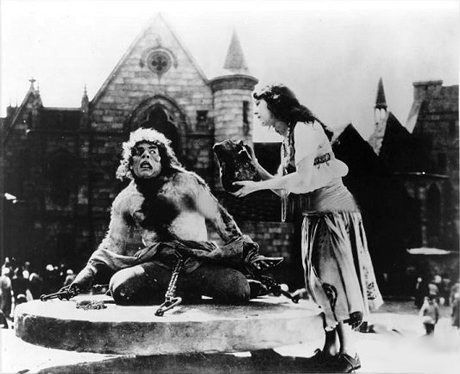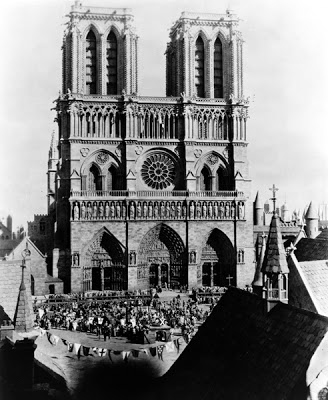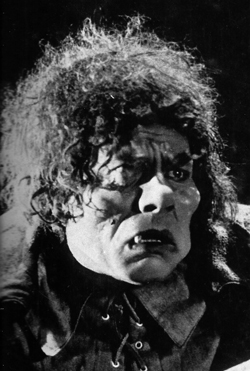Reviewed by Glenn Erickson
In 2007 Blackhawk Films released a good, intact 'Ultimate Edition' DVD of the silent classic The Hunchback of Notre Dame. Fans were excited to hear that a Blu-ray release was on the way, from Blackhawk in conjunction with Flicker Alley this time. We'd all been told that Chaney's breakthrough silent epic now exists only in 16mm prints, and mostly in a digest version. David Shepard, owner of the Blackhawk Films library, still has the best print source. Does this new release represent a marked improvement?
For many years, few film fans could see Chaney's Hunchback at full length. If the truth be told, most 'monster kids' of the 1960s knew the film from the excellent stills that would appear in Famous Monsters of Filmland magazine, and (no joke) through an excellent Aurora plastic model kit depicting Lon Chaney as Quasimodo, suffering on the public whipping wheel. The first clips I saw of Chaney were used as a cheap joke on the syndicated TV show Fractured Flickers. Now we know better.
The original movie is less a monster show than a fairly faithful simplification of Victor Hugo's elaborate historical romance. A straight pageant with few cinematic touches, the strongest element is Lon Chaney's magnetic characterization. While the other players are established with florid inter-titles, Chaney's expressive mime earns rather than demands audience sympathy. Chaney's physical appearance as the misshapen Quasimodo is so convincing, patrons of 1923 can be forgiven for believing that he could magically change his shape to fit his horrid characters. It's entirely credible that an aura of mystery arouse around the chameleon-like actor.

It's a big festival day in the center of Paris, and the feeble-minded hunchback Quasimodo (Lon Chaney) is crowned King of the Fools. The beggar chieftain Clopin (Ernest Torrence of Steamboat Bill, Jr.) assigns his thieves and fake beggars to work the crowd while his adopted daughter Esmeralda (Patsy Ruth Miller) entertains as a gypsy dancer. She immediately wins the heart of the officer Phoebus (Norman Kerry). Quasimodo observes as well, also struck by her beauty. Esmeralda rescues the poet Gringoire (Raymond Hatton) from Clopin's rabble while the unscrupulous Jehan (Brandon Hurst) uses Quasimodo in an attempt to kidnap the dancer. Phoebus rescues her and Quasimodo is unjustly punished with a public whipping. Clopin's beggars are ready to strike back at the hated aristocrats when the jealous Jehan stabs Phoebus, framing Esmeralda for the crime. Quasimodo saves his beloved gypsy from hanging and carries her to the sanctuary of the church. The state and the mob both want Esmeralda, but the hunchback defends Notre Dame from all entry.
The Hunchback of Notre Dame became one of Universal's biggest box office draws of the 1920s, reportedly making up in part for earlier expensive disappointments. Its lavish Paris set covered a huge chunk of Universal City and remained standing to serve as a backdrop for the studio's later cycle of horror pictures. Thousands of extras were filmed rioting beneath the replica of the Notre Dame cathedral. Elaborate special effects created the illusion of the cathedral's tower and the surrounding city.
Wallace Worsley's dull direction showcases the sets, occasionally finding a good high angle to represent Quasimodo's point of view. Slack storytelling fumbles an entire major subplot. An elaborate extended flashback establishes that Esmeralda is really the kidnapped daughter of a noblewoman, now driven mad with grief. (spoiler) That buildup all but mandates a melodramatic revelation, something on the order of the dramatic identity reveals in D. W. Griffith's exciting Orphans of the Storm. The issue is instead resolved in a perfunctory, offhand manner, robbing Esmeralda of a major emotional payoff.

The script uses 'poetic' visuals to convey certain ideas. When Phoebus seduces Esmeralda, we're shown an insect caught in a spider's web (an effect dulled by a redundant inter-title). Another 'visual simile' elides the actual moment of a stabbing: as a knife is drawn, the image cuts to a candle being blown out. When we cut back, the evil deed is done. The famous whipping scene is reduced to almost nothing. The whip flies once, and Quasimodo reacts once. Not one lash occurs on screen, and the scene is over before it begins. Quasimodo topples stones and molten lead from the battlements of the church, but we see few of the consequences to the mob below. We have to guess why Clopin is suddenly in such terrible shape.
The original picture almost certainly displayed a great deal more violence. According to commentator Michael F. Blake, 1923's censors were to blame. One close-up knife wound is still intact, most likely retained because it's the only indication that a stabbing has occurred. Without it we'd never know why the victim later collapses and dies, a major story point.
We've all read about the extremes of Chaney's makeup. A harness under his full body suit held the heavy hump in place, preventing the actor from standing up straight. Quasimodo's deformities are convincing even when he clambers up and down the cathedral exterior. His misshapen face looks like a vintage illustration and his dead eye must have been nightmarish for audiences of 1923. Yet the character generates considerable sympathy. Chaney's acting style is a cut above that of the other players, with their poses and static expressions -- the "Man of a Thousand Faces" has already found a more direct emotional connection with his audience.

Despite Lon Chaney's presence The Hunchback isn't a horror film. The imposed bittersweet ending softens the downbeat finale of Hugo's book, which had a far more epilogue: years later, dungeon keepers find Quasimodo and Esmeralda's skeletal corpses joined in a deathly embrace.
Blackhawk and Flicker Alley's Blu-ray of The Hunchback of Notre Dame is only a slight improvement on the 2007 Ultimate Edition DVD. It's still from the same 16mm print, although some sections may have been improved. The image doesn't look any less soft even though some surface damage seems to have been digitally erased. But this can't be called a real restoration - the image is still unsteady here and there so it's unlikely that more detailed digital intervention was undertaken.
The transfer is a full seven minutes shorter in duration than the 2007 DVD. The archivists sometime mix and match elements, but I cannot tell if scenes have been deleted, or if this HD transfer is done at a slightly faster frame rate, or both. I couldn't compare the discs side by side, and did not notice any missing material. Transfer and playback rates between formats have become so complicated that almost anything is possible. The film carries the same Donald Hunsberger symphonic score, conducted by Robert Israel.
Chaney biographer Michael F. Blake's commentary is back, and he's written a new essay for the disc's insert pamphlet. He explains the content of a few missing sections. At one point a dress and shoes for Esmeralda to wear just show up in the cathedral loft; in a lost scene, Quasimodo originally traded a box of candles for them.
Also repeated from the earlier edition is a reel of Lon Chaney visiting the Notre Dame set, and a 1913 one-reeler in which Chaney plays a boogeyman referred to as "Hunchback Fate." The photo section on the 2007 disc wasn't very impressive. Film authority Jack Theakston has assembled a very nice HD 'dynamic' montage of photos, as well as a tour of the original press book. The quality of these montages is excellent.
A highlight of Theakston's images is a letter to Carl Laemmle from a church representative who takes it upon himself to judge what acceptable film content should be - 1923 would seem to be smack in the middle of the scandal fallout from the Fatty Arbuckle tragedy. The church rep congratulates Universal for removing all the anti-Catholic content from Victor Hugo's novel. We almost expect the man to suggest that the classic book be burned.
One item not carried over from the old disc is a group of 3-D (red-blue anaglyphic) images of Chaney and the film's sets.
On a scale of Excellent, Good, Fair, and Poor,
The Hunchback of Notre Dame Blu-ray rates:
Movie: Very Good
Video: Good -
Sound: Excellent
Supplements: Insert essay and commentary by Michael Blake, Chaney biographer, excerpt from 1913 film featuring Chaney, newsreel footage of Chaney on the set, dynamic HD photo and press book galleries.
Packaging: Keep case
Reviewed: March 16, 2014

Text © Copyright 2014 Glenn Erickson
See more exclusive reviews on the Savant Main Page.
The version of this review on the Savant main site has additional images, footnotes and credits information, and may be updated and annotated with reader input and graphics.
Return to Top of Page
|

